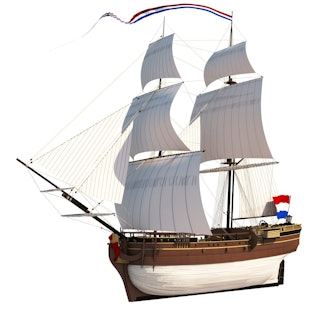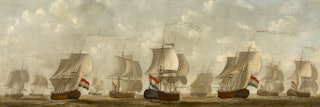The Dutch West India Company
The Dutch West India Company (WIC) was a slave trade business in the Republic of the Seven United Netherlands. The WIC existed from 1621-1792.
The company traded in the ‘West’. These are the area’s that border on the Atlantic Ocean: Western Africa and America. West-India was the name for Brazil, Berbice, Demerary (Guyana), Essequibo, Surinam and the Antilles in the Caribbean.
Trade
The WIC earned money with::
- Trade of goods (such as textile, ammunition, gunpowder, alcohol, iron rods, gold, ivory, sugar, coffee, cacao)
- Privateering (legally permitted pirating)
- Slave trade (purchasing of people in Africa and selling in West-India)
The company succeeded in conquering an area of Brazil. In what is now Ghana, the Elmina fort was conquered and used to trade the enslaved Africans.
Organization
The West-India Company was a national business with five offices, referred to as Chambers.
- The Chamber of Amsterdam
- The Chamber of Zeeland (Middelburg)
- The Chamber of De Maze (Rotterdam)
- The Chamber of the Northern Quarters (Hoorn)
- The Chamber of City and Land (Groningen)
The First and the Second WIC
The First West India Company existed from 1621-1674. In 1674 the company was dissolved. A new company was founded immediately. The Second WIC existed until 1792 and mainly dealt with slave trade. Until 1734 the WIC had the monopoly on the Dutch slave trade. This form of trade was also called trans-Atlantic slave trade, or triangle trade.
Trans-Atlantic slave trade or triangle trade
Ships departed from Western Europe with goods to Western Africa, where the goods were traded for gold, ivory and enslaved Africans. The Africans were shipped to West India, where they were sold to plantation owners. The ships returned from Western Africa and West India to Western Europe loaded with goods.
Between 1674 and 1740 the second West India Company embarked on 383 triangle voyages.

Zeelanders and the slave trade
Until 1730 the WIC had the monopoly on slave trade between Africa and South America. When they lost the monopoly, private individuals seized the opportunity to delve into this type of trading. Merchants from Flushing (Vlissingen) ordinarily traded alone or with a few other merchants. They undertook a total of 311 triangle voyages.
The Middelburg Commerce Company
The merchants from Middelburg united within the Middelburg Commerce Company (MCC). The MCC was founded in 1720. Early on the company traded in Europe, West India and Africa soon followed. After 1730 slave trade became the main source of income.
Triangle voyages
The first triangle voyage undertaken by the MCC departed in 1732 from Middelburg. The triangle voyages by the MCC went to the Upper coast (approximately the current Liberia and Ivory Coast) and the Gold Coast (now Ghana) or to the Lower Coast (the current Congo and northern Angola). From the African coast the ships set sail for the Guyana’s (Surinam, Berbice, Essequibo and Demerary) and or to St. Eustatius and Curaçao. From the Caribbean the ships returned to Middelburg. A triangle voyage lasted about 18 months.
In total the Middelburg Commerce Company embarked on 113 triangle voyages. The last MCC voyage was in 1802. The MCC, continuing as a wharf for roughly 80 years, was dissolved in 1889.

The Unity
Building
The Middelburg Commerce Company built her own ships in the wharf in Middelburg. The ship The Unity was launched in 1758. In 1759 it was completed. The Unity was a snow ship: a relatively small, quick sailing ship.
The first two voyages of The Unity were round trip voyages to Curaçao in the Caribbean. The third voyage (1761-1763) was the ships first triangle voyage.
Voyage 1761-1763
The Unity departed from Middelburg in 1761 with goods for trade to Western Africa. In Africa these goods were traded mostly for gold, ivory and slaves. The enslaved Africans were sold to plantation owners in the Caribbean. The Unity returned to Middelburg with goods from the plantations and goods from Western Africa. The goods were stored in large warehouses. After which they were sold through auction.
Logbooks
Much is known about the triangle voyages. Various persons aboard the ship kept logs. A log is a type of journal in which everything that happened was recorded.
The voyage taken by The Unity (1761-1763) was recorded in a log by first mate Daniël Pruijmelaar. The ship’s surgeon, Petrus Couperus, also kept a log. Captain Jan Menkenveld wrote letters and reports to the directors of the Middelburg Commerce Company.
Trade log and muster roll
From all the goods that went on board lists were made. In the trade log all commercial transactions were recorded. There are also overviews of the crewmembers. These overviews are called muster rolls.
Important documents
Because all these documents have been saved, we know what the circumstances on board were, what the weather was each day, which goods were transported and traded and who the crewmembers were. Logs, journals, trade logs, muster rolls and other ships documents are important archival pieces because they indicate precisely how a triangle voyage was.

